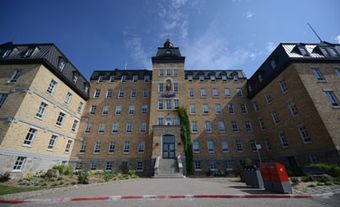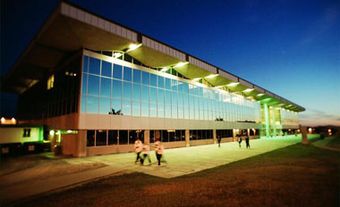
In 1907 the new Province of Saskatchewan chartered the University of Saskatchewan as a nondenominational, co-educational institution. Five centres lobbied to be the site of the university with Saskatoon being chosen in 1909. A 1032 ha tract, comprising a 146 ha campus, a university farm and experimental plots, was set aside in Saskatoon. In 1909 courses in arts and science were offered; Emmanuel College moved from Prince Albert to Saskatoon as an affiliate, and Rugby School in England donated a chapel for the new theological school. From 1912 to 1938 the university expanded, adding faculties of agriculture, engineering, law, pharmacy, commerce, medicine, education, home economics and nursing; graduate studies were added in 1946 and dentistry in 1965.
In an effort to promote post-secondary education, several junior colleges were authorized to give university credit courses. Of these, Regina College, affiliated in 1934, had the most significant impact on the university's development: in 1959 it was given degree-granting status, becoming the University of Saskatchewan's second campus. Degrees were granted after 1961. The Regina campus grew large in the years that followed and, by an Act of Legislation in 1974, the Regina Campus became an independent university, called the University of Regina.
Other federated and affiliated colleges include: St. Thomas More College (Catholic); Briercrest Bible College and Biblical Seminary (located in Caronport, Saskatchewan); Central Pentecostal College; College of Emmanuel and St. Chad (Anglican); Gabriel Dumont College; Lutheran Theological Seminary; St. Andrew's College (United); and St. Peter's Historic Junior College (located in Muenster, Saskatchewan). First Nations education and studies continue to be a particular interest of the University of Saskatchewan.
The University of Saskatchewan offers 58 degrees, diplomas and certificates in over 100 areas and disciplines. Colleges and schools include the following: Agriculture, Arts and Science, Commerce, Dentistry, Education, Engineering, Graduate Studies and Research, Kinesiology, Law, Medicine (including Physical Therapy), Nursing, Pharmacy and Nutrition, and the Extension Division. The University of Saskatchewan's program in agriculture has grown to include three additional experimental farms totalling 1847 ha in area and one of four schools of include Veterinary Medicine in Canada. In January 2000, the Virtual College of Biotechnology was established. The objective of the College is to be active in co-ordinating, strengthening, and encouraging collaboration among the life sciences, social sciences, humanities, management, and marketing disciplines involved in biotechnology. Approximately 20 000 students are enrolled at the University of Saskatchewan.

 Share on Facebook
Share on Facebook Share on X
Share on X Share by Email
Share by Email Share on Google Classroom
Share on Google Classroom


